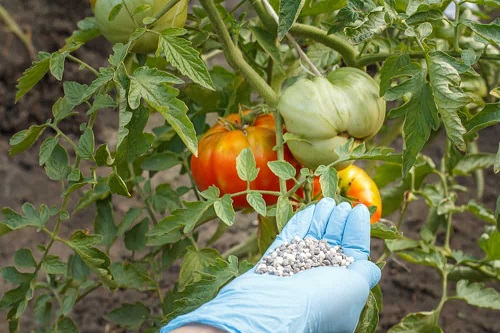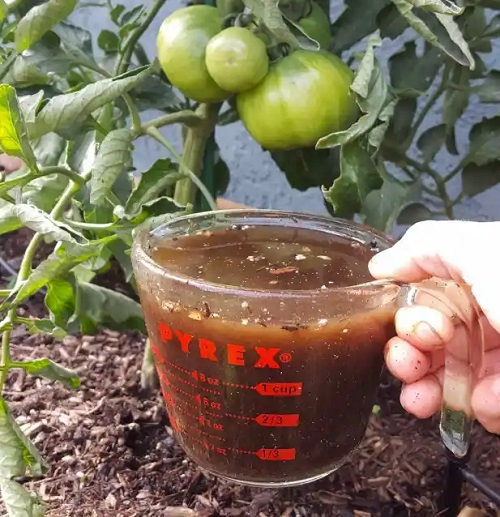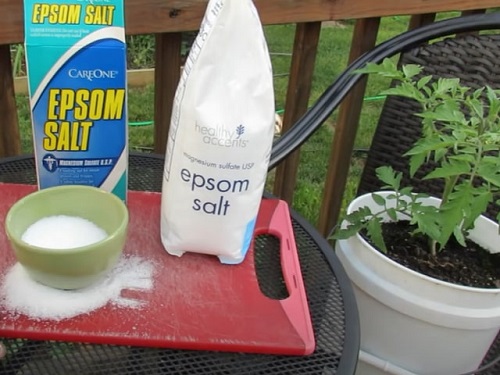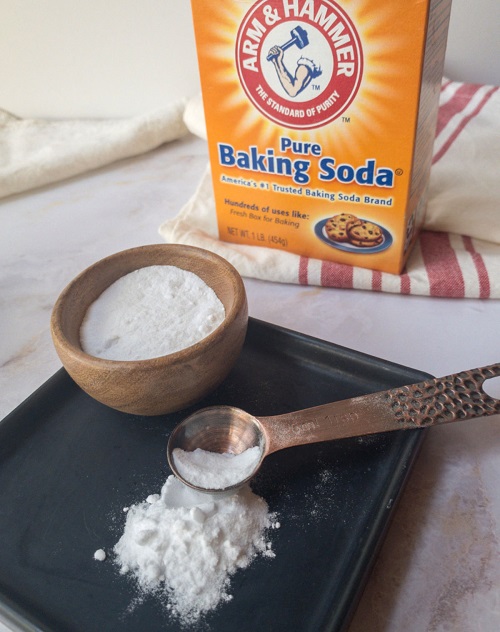Want to know about the Best Homemade Fertilizers for Tomatoes? Well, we have included the ones to help you in a bumper harvest!
It’s important to exercise caution when using Homemade Fertilizers for Tomatoes found online, as they often contain excessive amounts of nitrogen. While nitrogen is beneficial during the early stages of growth, tomato plants require varying nutrient levels as they progress through different growth stages. An overabundance of nitrogen in the later stages of growth can hinder fruit production.
Rather than relying on a recipe sourced from the internet, it is recommended to create your own tomato fertilizer recipe to ensure the appropriate nutrient balance for your plants.
Find out the 11 Best Herbs to Plant with Tomatoes here
What Nutrients Do Tomato Plants Require?
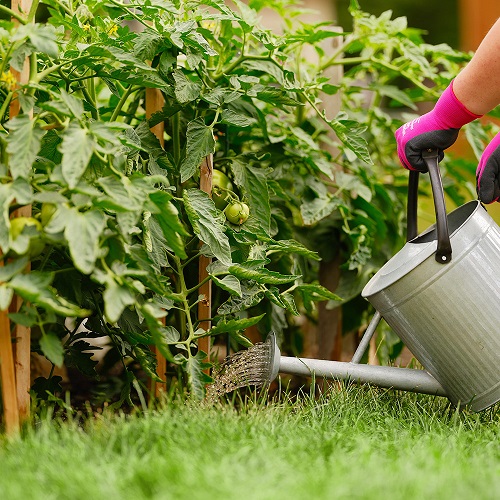
Before you use Homemade Fertilizers for Tomatoes, it is important to ensure the proper growth of tomato plants; gardeners must understand the nutrients required by the plants at various stages of their growth cycle.
As the plants mature, their nutrient requirements change, and it is essential to comprehend these needs to determine the optimal timing for fertilization with different types of fertilizers. By comprehending the nutrient requirements of tomato plants at each growth stage, gardeners can ensure the plants receive the appropriate nutrients at the appropriate time for optimal growth.
Making Homemade Fertilizers for Tomatoes helps in the crucial growth of tomato plants, as they are known to be heavy feeders. The three primary nutrients necessary for plant growth and development are nitrogen, potassium, and phosphorous; each serving has a distinct purpose.
To promote optimal growth at every stage of development, tomato plants require varying levels of these nutrients. Therefore, it is essential to understand the nutrient requirements of the plants at each stage of growth to ensure proper fertilization.
Follow the Number One Technique to Produce Sweeter Tomatoes here
Nutrient Requirement While Transplantation
Before diving deep into making Homemade Fertilizers for Tomatoes, it is important to understand that nitrogen is a crucial nutrient for the growth of tomato plants. Still, it is essential to exercise caution when using it.
If you have already added compost to the soil when transplanting your seedlings, it is unnecessary to add more nitrogen, as over-fertilization can potentially burn or harm the plants.
Regarding soil requirements, phosphorous is an essential nutrient that may need attention. If your compost is abundant in banana peels and bones, it may already contain enough phosphorous for the initial growth phase of the plants. However, if this is not the case, it is advisable to add small amounts of bone meal to the holes while planting the seedlings.
Nutrient Requirement in the Growth Phase
Nitrogen plays an important role in forming vital plant structures such as chlorophyll, particularly during the growth phase. Adequate amounts of nitrogen should be present in healthy soil and compost to sustain this growth stage.
However, if you observe yellowing of the leaves at the bottom of the plant, this indicates a nitrogen deficiency and additional nitrogen fertilizer is required to ensure optimal growth. This is where the Homemade Fertilizers for Tomatoes will come into play.
Nutrient Requirement While Fruiting
Potassium is a crucial nutrient required by tomato plants throughout their entire growth cycle. During the later stages of growth, it is crucial to avoid over-fertilization with nitrogen as it can lead to excessive leaf growth and insufficient flowering, ultimately leading to reduced fruit production.
To promote robust and healthy growth at this stage, it is necessary to add sufficient amounts of potassium to the soil. It is recommended to maintain potassium levels double that of nitrogen to ensure the optimal balance of nutrients required for the plant’s healthy development. All this is achieved by the Homemade Fertilizers for Tomatoes.
Find 4 Amazing Ways to Use Penny in Garden (#1 is for Healthy Tomatoes) here
When to Fertilize Tomato Plants?
Before you make Homemade Fertilizers for Tomatoes, it is essential to understand that tomato plants require fertilization at various stages of their growth cycle, beginning with the seedling phase.
When planting the seedlings, it is recommended to add compost or fertilizer to the hole and mix it gently with the soil. The requirement for additional fertilization depends on the soil quality and existing nutrient levels.
If the soil has been enriched with quality compost, additional fertilization may not be necessary immediately after planting. However, it is essential to monitor the growth of the plants carefully to determine if additional nutrients are needed.
Once the plants start flowering and bearing fruit, it is time to fertilize them again. At this stage, it is recommended to use diluted fertilizers, ensuring an adequate supply of potassium around the base of the soil to promote healthy fruit and overall plant growth.
Find Using Eggshells for Tomatoes for Bumper Harvest here
How to Make the Best Homemade Tomato Fertilizers
Homemade Fertilizers for Tomatoes are the best way to boost their growth. The availability of resources plays a crucial role in determining the type of fertilizer that you can use for your tomato plants.
For instance, if you keep chickens, it makes sense to use their manure as a fertilizer, but it must be composted before use. Similarly, rabbit manure can provide nutrients to your plants, but it’s only feasible if you have access to it.
Find how to make the best homemade tomato fertilizer recipe.
1. Wood Ash
Wood ash obtained from a wood-burning fireplace is a great source of potassium and phosphorus for your tomato plants.
When applying homemade fertilizers to your tomato plants, it’s important to be mindful of the quantity you use. Adding excessive amounts can raise the soil’s pH level, resulting in an overly alkaline environment. This may not be ideal, depending on the natural pH level of your soil. Therefore, exercise caution to avoid this issue.
It’s worth highlighting that homemade fertilizers can be highly beneficial for tomatoes. In fact, they are regarded as one of the best Homemade Fertilizers for Tomatoes. So, while being mindful of the potential pH impact, you can confidently utilize homemade fertilizers to enhance the growth and development of your tomato plants.
Read in detail about Using Wood Ash in the Garden here
2. Cottonseed Meal
When it comes to nourishing your tomato plants, Cottonseed Meal proves to be a highly effective organic fertilizer. This natural fertilizer offers a balanced blend of vital nutrients, including nitrogen, phosphorus, and potassium, which are essential for promoting healthy growth in your plants, regardless of their stage of development.
One notable advantage of Cottonseed Meal is its slow-release nature. The nutrients it contains are released gradually over an extended period spanning approximately four months. This gradual release ensures a steady supply of nourishment to your tomato plants, supporting their sustained growth and overall well-being.
3. Kelp Meal
Looking for Homemade Fertilizers for Tomatoes but all out of wood ash? If you find yourself without wood ash, there’s an alternative solution to enhance the potassium levels in your soil. Adding a few cups of kelp meal can effectively serve this purpose.
This is particularly significant to bear in mind during the later stages of growth when your tomato plants enter the flowering and fruit-bearing phase. Potassium holds immense importance during these critical stages, contributing to the overall success of your tomato harvest.
Learn how to Use Coco Peat for Bumper Tomato Harvest here
4. Coffee Grounds or Tea Leaves
Coffee grounds and tea leaves contain nitrogen in small amounts, which can be beneficial for tomato plants. Nitrogen is a crucial nutrient required for the plant’s growth at all stages, but the quantity required during the final phase is relatively lesser.
Therefore, using coffee grounds and tea leaves can be a suitable option for providing a sufficient amount of nitrogen to the tomato plant.
Here are Awesome Coffee Filter Uses in the Garden
5. Blood Meal
If you find that your soil requires higher nitrogen levels after conducting proper soil testing, adding a small amount of blood meal, such as half a cup, can be an effective solution.
A blood meal is known to have the highest concentration of nitrogen among all types of fertilizers, ranging from 9-14%; hence adding only a small amount is recommended.
6. Bone Meal
Bone meal typically has a nutrient ratio of 3-15-0 (N-P-K), but it can vary depending on the source, with some containing as much as 2-22-0. The “N” represents nitrogen, “P” represents phosphorous, and “K” represents potassium.
Steamed bone meal contains beneficial nutrients such as phosphorous (18-24%), nitrogen (0.7-7%), and calcium. These nutrients promote healthy flower and fruit production in plants and help to balance the soil’s nitrogen and other nutrient levels.
Learn How To Make Bone Meal Fertilizer At Home here
7. Rice Water
Don’t stop yet. Here’s another one on the Best Homemade Fertilizers for Tomatoes! Rice Water.
Rice Water contains up to 45-50 percent phosphorus that boosts the growth of tomatoes; read in detail about these Proven Rice Water Benefits for Plants here.
8. Banana Peel Fertilizer
Did you know that banana peels are an excellent source of phosphorus? By incorporating banana peels into your tomato plants’ soil, you can promote healthy growth and enjoy sweeter tomatoes as a result. Read more here.
9. Alfalfa Pellets
An effective method to gradually increase nitrogen levels in your soil is by utilizing alfalfa pellets as a natural fertilizer. To use alfalfa pellets in a tomato fertilizer recipe, it’s important to first lightly dampen them until they are on the verge of breaking apart.
Furthermore, it’s crucial to mix the pellets thoroughly with the recipe to ensure the nitrogen is evenly distributed throughout the soil.
10. Pet or Human Hair
Including pet or human hair in your DIY tomato fertilizers can be highly beneficial as it provides a slow-release source of nitrogen. These also release keratin, a protein that tomato plants require, making it one of the most amazing Homemade Fertilizers for Tomatoes.
However, it’s important to cut the hair into fine pieces to ensure it blends well with the fertilizer mixture and doesn’t clump up.
How to Make Liquid Tomato Fertilizer
Other effective Homemade Fertilizers for Tomatoes are liquid ones.
11. Compost
The foundation of any good tomato fertilizer recipe is high-quality compost. Compost is the best option for tomato plants, and ideally, you should use homemade compost made from vegetable scraps and other leftover materials around your home.
However, if you don’t have homemade compost, look for organic compost at the store. If you raise cows, chickens, or rabbits, consider using composted manure instead of typical compost.
Compost should make up half of your tomato fertilizer. It is an all-purpose fertilizer that contains most of the nutrients that your plants need, including essential nutrients, macronutrients, and micronutrients.
Additionally, compost feeds your plants throughout the entire growing season. If you don’t have homemade compost, mix well-rotted manure and coconut coir.
12. Vermicompost
To prepare a nutrient-rich soil mixture, start by taking half a gallon of your compost blend and placing it into a bucket. Ensure that the mixture is well combined by breaking up any clumps.
Next, enhance the soil mixture by adding two cups of vermicompost, which will introduce beneficial microbes to the soil. Additionally, mix in two cups each of powdered eggshells and rabbit or hamster droppings.
These ingredients will provide valuable nutrients to the soil and help promote healthy plant growth.
13. Potassium and Phosphorus
To increase the levels of potassium and phosphorus in your soil mixture, add one cup of wood ash. Wood ashes have multiple beneficial uses in the garden.
Alternatively, if you have difficulty obtaining wood ashes, you can use two cups of kelp meal to boost the potassium levels and half a cup of bone meal to add phosphorus to the soil mixture. These ingredients will provide the necessary nutrients to support healthy plant growth.
Read about the DIY Potassium Rich Plant Fertilizer here
14. Nitrogen
For a slow-release source of nitrogen to benefit your tomato plants, you can add one cup of used coffee grounds or two cups of alfalfa pellets to your soil blend. If you choose to add alfalfa pellets, ensure they disintegrate properly by adding water to them before including them in your mixture.
If you require a more significant nitrogen boost, half a cup of blood meal can be added to the soil blend.
An unconventional but effective way to provide nitrogen to your tomato plants is by adding finely cut pet hair or human hair to the mix. As hair decomposes, it releases nitrogen and keratin – a protein that promotes strong plant growth.
Note: Allow your fertilizer to infuse for approximately a month before use, and ensure it is stored in a sealed container. This step is crucial to ensure that the fertilizer is adequately matured and ready for use.
Liquid Organic Tomato Fertilizer Recipe
In case you prefer liquid fertilizer, you can prepare Homemade Fertilizers for Tomatoes using the following tips:
- Firstly, mix one pound of the homemade fertilizer created above with a gallon and a half of water. Stir the mixture well a couple of times a day.
- Place the bucket containing the mixture with the lid on in an area protected from extreme heat or cold.
- Allow the compost tea to steep for five days, ensuring it remains undisturbed.
- After five days, strain the liquid and use it immediately without diluting it. You can add the solid residue to your compost pile or sprinkle it around the base of your tomato plants.
Epsom Salt Liquid Fertilizer
Epsom salt is a natural source of magnesium and sulfur, which are beneficial for plant growth. Magnesium helps to prevent yellowing leaves and gives the leaves a deeper green color, while sulfur helps in root growth, protein, and enzyme production and protects plants from cold temperatures. It also promotes blooming flowers and sweeter fruits.
- To make an Epsom salt fertilizer, you will need Epsom salt and fresh water, as well as a 1-gallon container or sprayer.
- For soil nutrients, mix one tablespoon of Epsom salt with a gallon of water for plants that are 1 foot tall and two tablespoons for plants that are 2 feet tall.
- As a foliar spray, mix one tablespoon of Epsom salt with a gallon of water and apply directly to the foliage.
Epsom salt can be applied to tomato plants at different stages of growth, including during transplant, when they begin flowering, and when they start to produce their first fruits.
It is recommended to apply the solution every 2 to 4 weeks, depending on how the plants respond. In fact, you should check how your tomato plants respond to all of these Homemade Fertilizers for Tomatoes.
Check out the DIY Dandelion Fertilizer Recipes here
Fish Emulsion Fertilizer
Fish emulsion is an important part of the Homemade Fertilizers for Tomatoes as it contains the essential nutrients of phosphorus, nitrogen, and potassium, as well as micronutrients like magnesium, calcium, and sulfur. It is a slow-release fertilizer that provides nutrients to the plants over the growing season without overfeeding them.
- To make a balanced fish emulsion fertilizer, you will need fish waste or leftovers, equal portions of bone and soft parts, seaweed or kelp, blackstrap molasses, and a five-gallon container.
- You can also add high-quality compost, coffee grounds, crabs, or Epsom salt, depending on your soil’s needs.
- To create the fertilizer, mix one-part fish waste with five parts water in the five-gallon container.
- Add chopped seaweed or kelp, blackstrap molasses, and any additional ingredients as needed.
- Stir the mixture thoroughly with a stick, and cover the container with a lid with a small hole to allow gas to escape but prevent flies from entering.
- Keep the container away from your home and stir the mixture several times for the first two weeks.
- Homemade fish emulsion fertilizer can last up to 12 months, after which you should start a new batch.
- Apply three tablespoons per gallon of water to the soil once a month or one tablespoon per gallon of water as a foliar spray once or more per month.
- Use the foliar spray in the morning before the day becomes too hot.
You can apply the fish emulsion fertilizer directly to the plants or soil, and it works best during transplanting and throughout the growing season. Be aware that fish emulsion produces a strong odor during fermentation, so take precautions to avoid unpleasant smells.
Note: After straining the liquid, you can add the leftover fermented emulsion to your compost pile. It is one of the most important ingredients in Homemade Fertilizers for Tomatoes.
Check out Dried Banana Peel Powder Fertilizer at Home for Any Plant here
Banana Peel Tea for Tomatoes
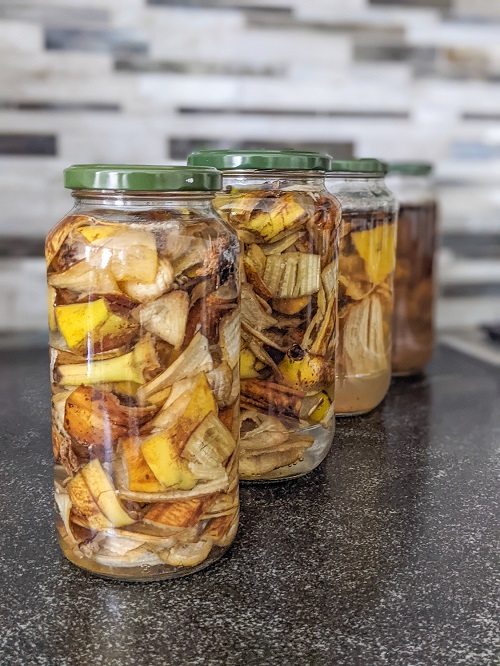
Did you know that Banana peels make excellent Homemade Fertilizers for Tomatoes? Banana peels are a natural source of potassium, phosphorus, calcium, and other trace minerals.
They are particularly beneficial for slightly acid-loving plants such as tomatoes and can help prevent blossom end rot while promoting healthy root growth and blooming. Find the recipe here.
Check out the Super Quick Banana Peel Powder Fertilizer Recipe for More Flowers here
Baking Soda for Tomatoes
Last but not least on the list of Homemade Fertilizers for Tomatoes is baking soda. When used as a fertilizer, baking soda helps regulate the pH levels in the soil, making it less acidic. This can result in sweeter-tasting tomatoes. Baking soda can be utilized as a cost-effective and environmentally friendly fertilizer for tomato plants.
- To make a baking soda fertilizer, simply mix one tablespoon of baking soda with a gallon of water. Stir the mixture well to ensure the baking soda is dissolved. Here is the detailed recipe.
- Apply the baking soda spray to both the tops and bottoms of the tomato plant leaves, ensuring thorough coverage.
- Spray the tomato plants every seven to ten days, especially during humid or damp weather conditions.
- Use the baking soda spray in the evening when temperatures are cooler, avoiding direct sunlight and high temperatures to prevent leaf burn.
- Test the spray on a few leaves before applying it to the entire plant to ensure the tomato plants tolerate it well.
- Remember to mix a fresh batch of the baking soda spray each time you use it for optimal effectiveness.


